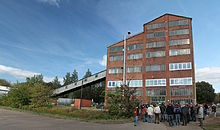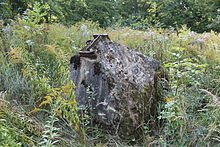Ida-Bismarck mine
| Ida-Bismarck mine | |||
|---|---|---|---|
| General information about the mine | |||
| Daytime systems at the Ida shaft in 1957 | |||
| other names | Ida Union; Salzgitter Union | ||
| Mining technology | Expansion construction | ||
| Funding / total | 6.4 million tons of iron ore | ||
| Information about the mining company | |||
| Operating company | Barbara Erzbergbau AG | ||
| Employees | up to 483 (1944) | ||
| Start of operation | 1868 | ||
| End of operation | October 10, 1962 | ||
| Funded raw materials | |||
| Degradation of | Brown iron stone | ||
| Greatest depth | 324 m | ||
| Geographical location | |||
| Coordinates | 52 ° 1 '0.8 " N , 10 ° 23' 28.2" E | ||
|
|||
| Location | Othfresen | ||
| local community | Liebenburg | ||
| District ( NUTS3 ) | Goslar | ||
| country | State of Lower Saxony | ||
| Country | Germany | ||
| District | Peine-Salzgitter area | ||
The Ida-Bismarck mine was a comparatively small iron ore mine in the Salzgitteran mining district . It was located near the village of Othfresen ( Liebenburg municipality ) in the Goslar district ( Lower Saxony ), in the southeastern part of the Salzgitter ridge . A rubble ore deposit from the Lower Cretaceous , which was striking here, was mined .
The mine was last operated by Barbara Erzbergbau AG .
geology
The Brauneisenstein deposit of the Ida-Bismarck ore mine was located on the northwest-southeast edge of the Salzgitter ridge. In a trending direction, it extends from the so-called shepherd's chair near Salzgitter-Grid to Othfresen-Posthof. The camp falls on average at 50 gon from northeast to southwest. The building-worthy thickness was up to 25 meters with an iron content of 25 to 30%.
The formation of the camp proceeded like that of the other deposits in the Salzgitter district: the coastline of the Lower Cretaceous Sea was in the area of the Salzgitter ridge. In the area of decaying marine organisms dissolved in water iron compounds could very well precipitate , forming so-called Toneisenstein- geodes . These were preferentially deposited in natural depressions near the coast due to the sea surf. Due to the weathering processes after the water withdrew, they disintegrated into numerous rubble. During subsequent floods, iron oolites were deposited in the same place . The originally flat deposits (also called ore ponds ) that were created in this way were disturbed and erected over the course of millions of years by tectonic processes and / or rising salt domes.
history
Precursor mining
On December 3, 1682, the entrepreneur Jobst Edmund von Brabeck from the county of Mark an der Innerste founded the Kunigunde ironworks . In 1687, Brabeck had an iron stone tunnel lent to the Grenzlerburg to supply ores from the surrounding area . The chalky outcrop of the later Ida camp had been known for a long time. Since the molten iron was of poor quality, operations at the Kunigunde ironworks were discontinued in 1693; after a further operating phase, the ironworks was shut down in 1738 at the latest.
In the 18th and 19th centuries, the Salzgitteran deposits including the camp at the Grenzlerburg were examined several times by the sovereigns and experimental mining was undertaken. The high silica content stood in the way of effective smelting and thus of interest in mining. Nevertheless, from 1857 onwards, several mining fields were awarded in Othfresen , including the Ida field in 1868 .
There was little initial mining activity in Othfresen in the years 1870 to 1873 in the Helene and Ludwig mine fields . There 15 men extracted 6,000 tons of ore a year for the Othfresen blast furnace . It was built in 1869 by the major railroad contractor Bethel Henry Strousberg . With the end of the Franco-Prussian War in 1871, Lorraine and its extensive mines fell to the German Empire . As a result, the Salzgitter ores were no longer competitive and all activities came to a standstill.
After the loss of the First World War , Lorraine fell back to France and the iron-making industry of the Weimar Republic had to look for a new domestic raw material base. Now the Salzgitter ores and with them the Ida camp also attracted interest again. The first new research work was carried out in 1921 by the Ilseder Hütte . The Rombacher smelters were from 1924 to 1925 the Rombacher tunnel west of the station Othfresener mount up . It was deferred without reaching the ore deposit and acquired in 1927 together with all ore fields by the raw materials operations of the United Steel Works (VESTAG).
Operation of the Ida-Bismarck mine from 1934 to 1962
In 1934 the exploration work in the area of the Ida-Bismarck mine was revitalized. There were two reasons for this: on the one hand, the National Socialist regime put pressure on the German coal and steel companies to expand their domestic resources. On the other hand, the metallurgical engineers Paschke and Peetz in Clausthal had developed an acidic smelting process , which allowed the processing of the poor , high-silica ores.
In 1935 the Ida union became part of the Salzgitter union and VESTAG had the tunnel started by the Rombacher Hütte, now called the Ida tunnel, completed up to a length of 1000 meters. A blind shaft sunk from there was intended to investigate the deeper parts of the deposit. The most necessary operational buildings were erected on the colliery square in front of the mouth hole . As early as 1936, around 10,000 tons of ore were extracted with a workforce of only 63.
In contrast to the ore mines in the city of Salzgitter , Ida-Bismarck, like its neighboring mines in Dörnten and Groß Döhren, was not taken over by the Reichswerke Hermann Göring and remained with VESTAG.
The Bismarck day shaft was sunk on the Posthof-Liebenburg road to develop the south-western parts of the field and for ventilation . The Heimerode miners' settlement was built near it . Two underground levels were connected to the 108 m deep shaft , the upper one was cut through in 1940 with the Ida tunnel . The wooden sinking frame was also used for mining and driving after the facility was completed . Apart from a hoisting machine house and a combined operations building, the shaft system had no other buildings.
The Ida shaft was built west of the Grenzlerburg between 1939 and 1940 ; it served as the main shaft. However, the ores from the total of 5 civil engineering floors were not lifted to the hanging bank of the shaft, but only to the Ida tunnel floor (= blind extraction). In the latter which occurred promotion until after about day by the Stollenmundloch . An ore processing plant with an output of 1,400 tons per day was built nearby from 1940 to 1941 . In 1940, more than 400 miners were already mining almost 250,000 tons of raw ore per year in piers . The concentrates obtained were taken by train to Hildesheim , from where they were shipped to the Ruhr area on the Mittelland Canal . In the course of the Second World War , production fell again after a high of 325,000 tons in 1941. With the collapse in May 1945 it finally came to a complete standstill. The mine drowned due to the shutdown of the pumps.
At the end of 1945 the mine was swamped and production resumed. The former ore mine ownership of the forcibly dissolved VESTAG was transferred to the newly founded Barbara Erzbergbau AG , based in Wülfrath . The production figures of the early war years could not be reached again until 1952. As a degradation process has now - as on the neighboring mines - the Weitungsbau applied. An above-average number of miners on Ida-Bismarck were refugees from Silesia (compared to the other ore mines in the vicinity of Liebenburg) . The ore reserves in the vicinity of the Bismarck shaft were already exhausted in 1949, the shaft was dropped and filled . As an alternative, a 100 m deep stacking shaft was sunk from 1948 to 1952 to open up the remaining stocks of the so-called Bismarck camp 2 km south . The heavily fissured Bismarck camp was finally eradicated in 1955. Instead, dismantling was planned on the 4th and 5th Ida levels in a southerly direction, which until then had been under water and were being prepared further. Since the demand for ore concentrates decreased by the smelters on the Ruhr, the mine also supplied the Krupp racing facility of the Salzgitter smelting works from 1956 .
In September 1957, a railway accident occurred on the 4.5 km long mine connection line from the Fortuna mine in Groß Döhren to the Ida mine. A fully loaded ore train coming from Fortuna crashed into an empty train in the Ida mine station. The cause was a defective brake system. The locomotive personnel suffered serious injuries and major property damage occurred.
In 1957, the highest annual production in the history of Ida-Bismarck was achieved with almost 400,000 tonnes per year. At the same time, the decline began. There was no longer any degradation below the third level. The ore processing was shut down in 1960 and the raw ore was processed at the Fortuna mine. When the Krupp racing facility was closed, the Ida-Bismarck mine was closed almost simultaneously on October 10, 1962.
After the closure, the Ida shaft was backfilled and the mouth hole of the Ida tunnel was closed. After the headframe was dismantled, the hoisting machine house and the shaft hall were preserved until the beginning of the 2000s. A remnant of the guide sticks protruded from the filled shaft . For reasons of accident prevention, the community of Liebenburg had the dilapidated buildings in the forest demolished at its own expense. Remnants of the foundations are still visible today.
Current condition
In contrast to most of the other ore mines in the Salzgitter area, larger parts of the surface facilities have been preserved from the Ida-Bismarck mine at the Ida tunnel . On the Zechenplatz near the Othfresen train station, commercial establishments use the chewing , administrative and several workshop and auxiliary buildings. The processing building on the Goslar – Hildesheim railway line can be seen from afar as a striking landmark of the Othfresen mining industry. According to its purpose, it is used today by the Study Society for Iron Ore Processing as a technical center.
At the Bismarck shaft, on the road from Othfresen to Heimerode, a mural on the former company building reminds of the original appearance of the small shaft.
literature
- Rainer Slotta : Technical monuments in the Federal Republic of Germany - Volume 5, Part 1: The iron ore mining . German Mining Museum, Bochum 1986.
- Heinrich Korthöber et al .: Mining in Salzgitter . the history of mining and the life of miners from the beginning to the present. In: Archives of the City of Salzgitter (Ed.): Contributions to the city's history . tape 13 . Appelhans, Salzgitter 1997, ISBN 3-930292-05-X , p. 420 .
- Manfred Watzlawik et al .: Fortuna, Morgenstern, Georg-Friedrich . History and stories of ore mining near Döhren. Ed .: Döhrener Mining Working Group. Self-published, Groß-Döhren 1983, p. 89 .





